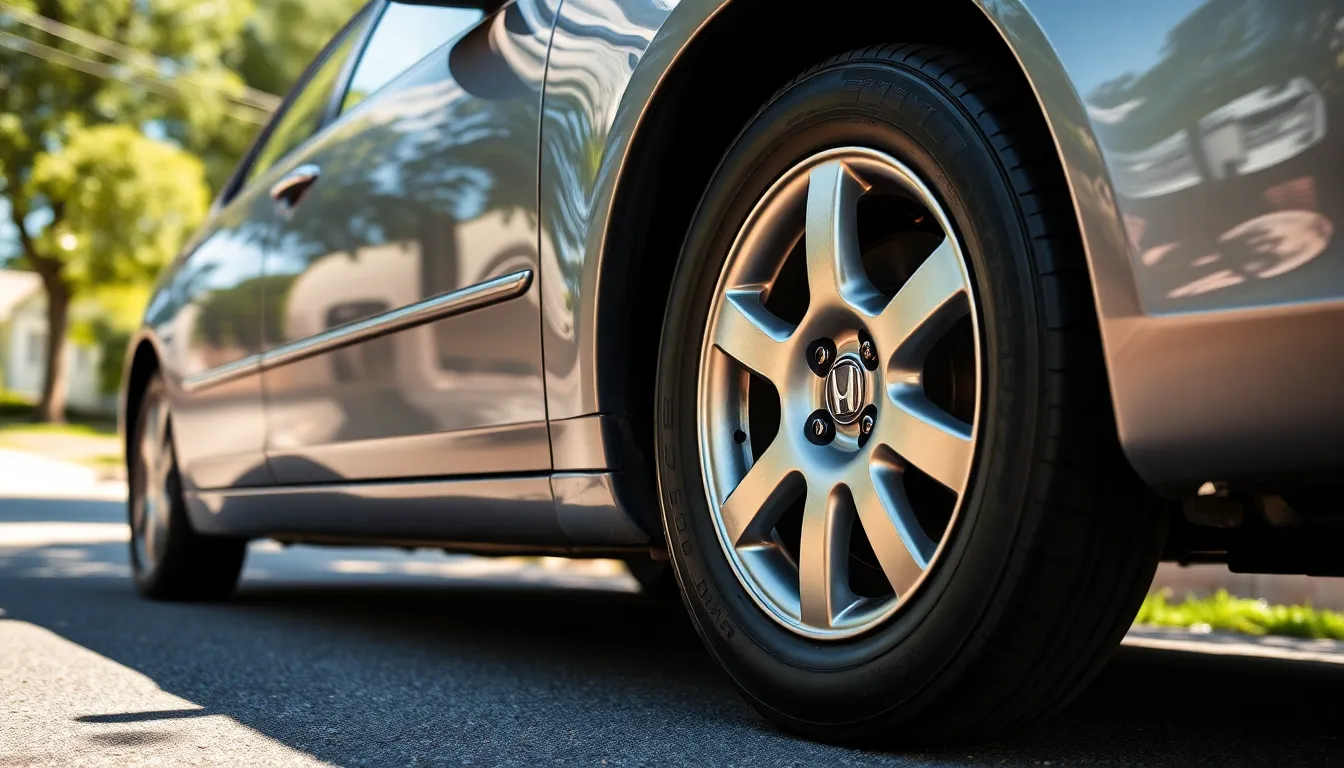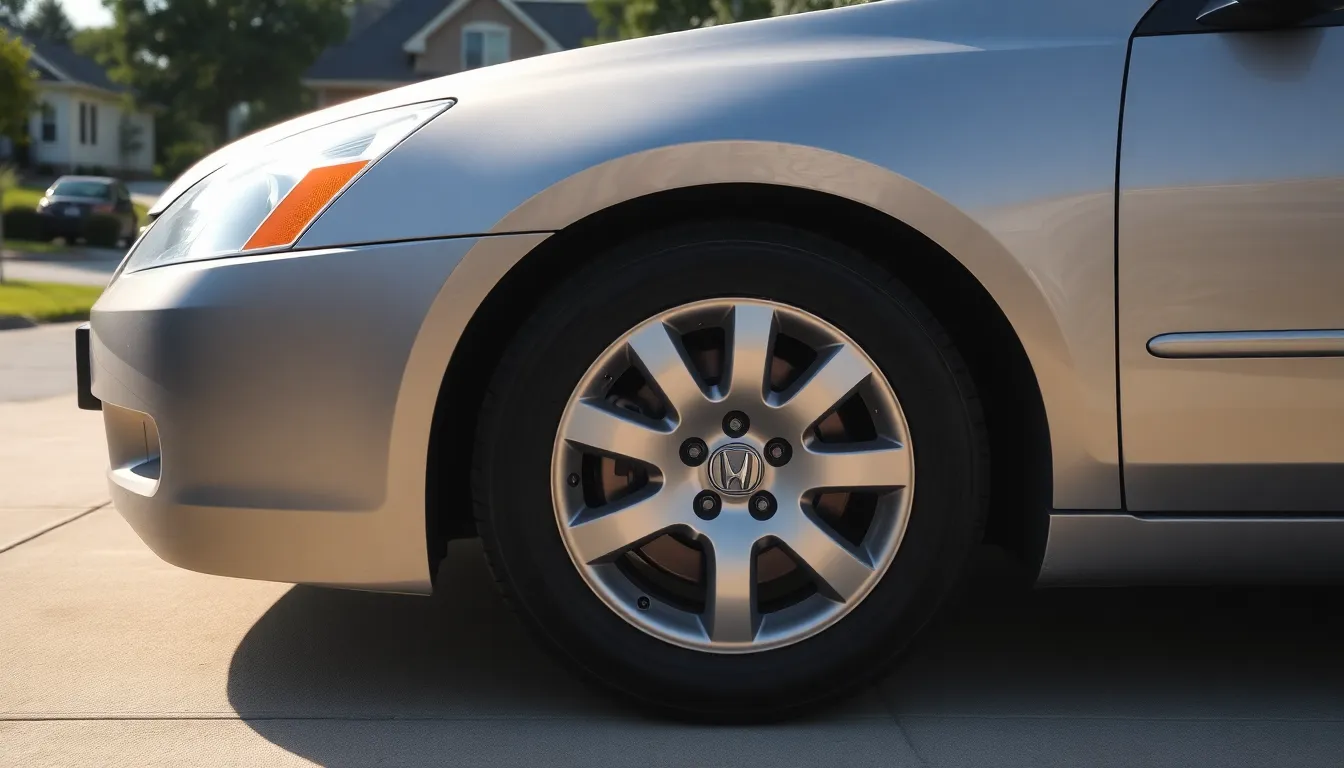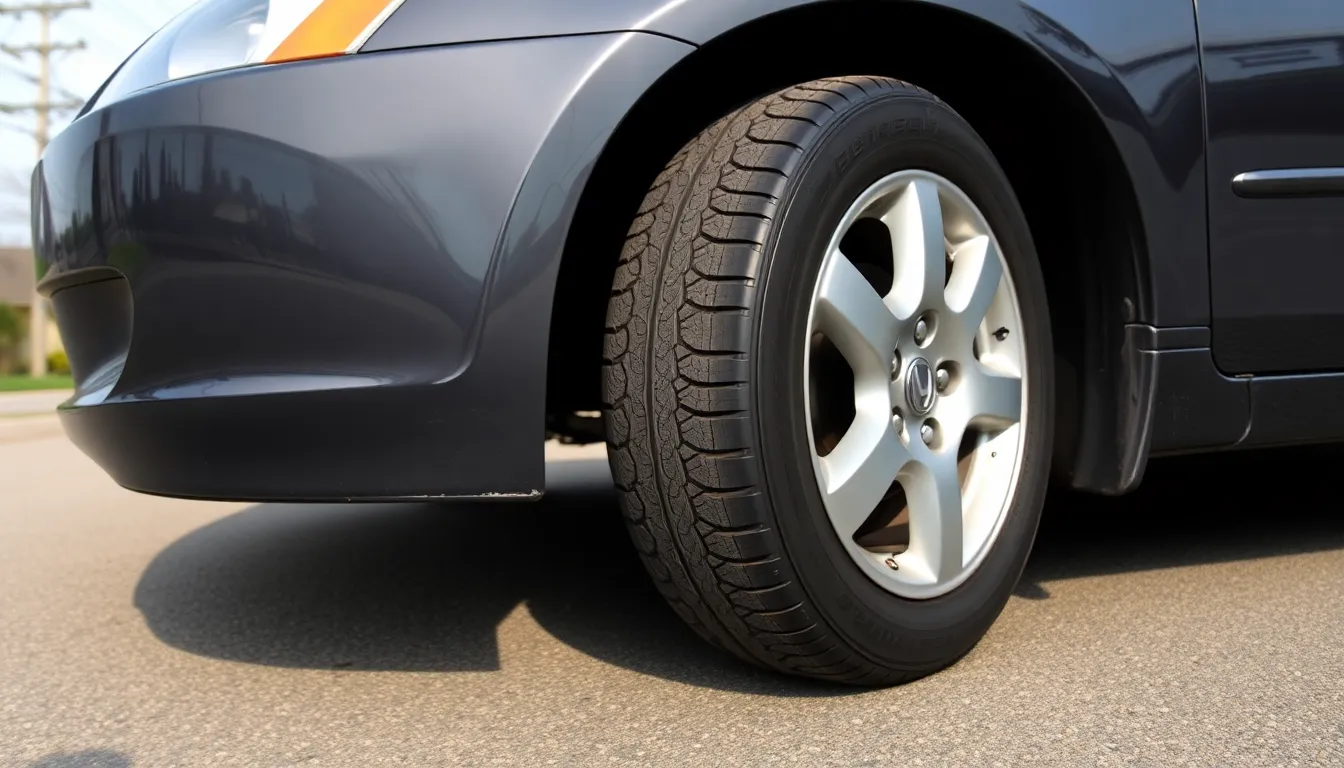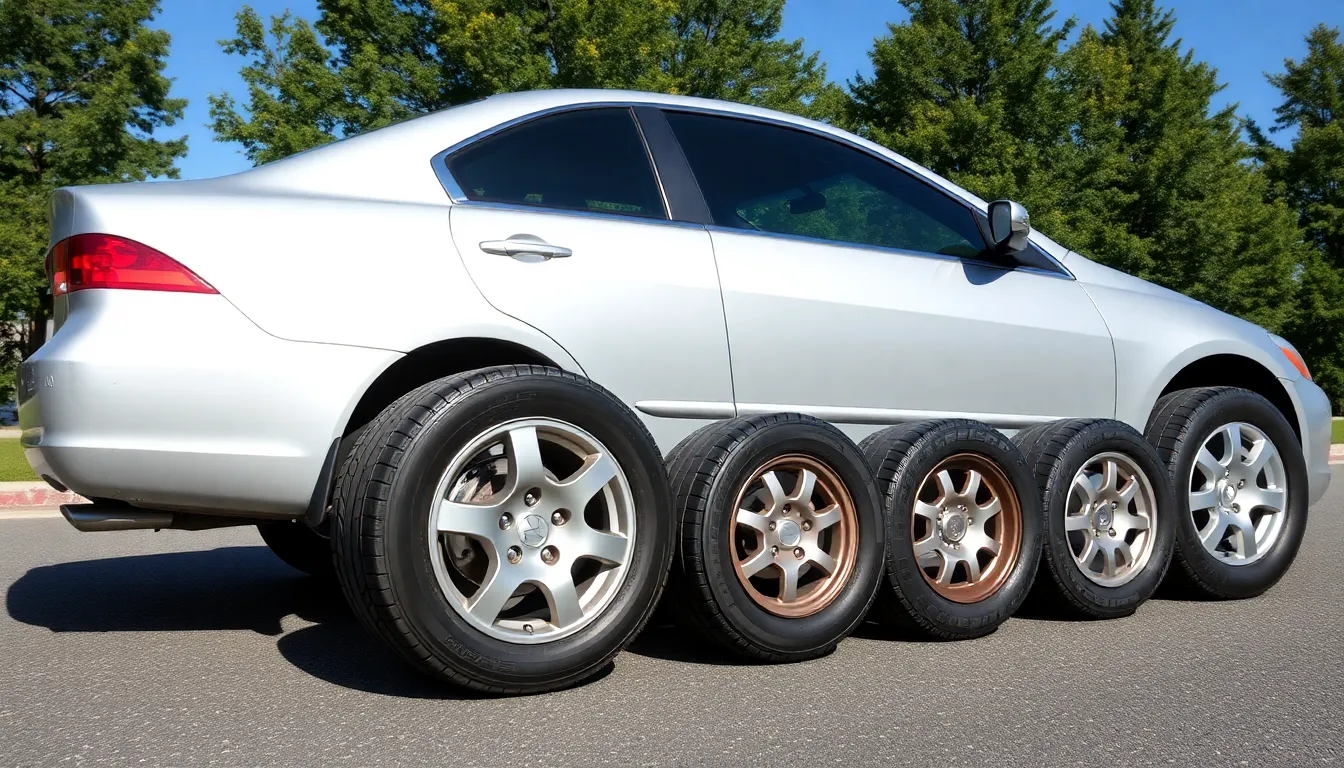Are you looking for the correct 2004 Honda Accord tire specs for your vehicle? Finding the right tires isn’t just about fit—it’s about maximizing your car’s performance, safety, and fuel efficiency.
When it comes to maintaining your 2004 Accord, understanding the factory tire specifications is essential. The right tire size, pressure, and type can significantly impact your driving experience. Whether you’re replacing worn tires or upgrading for better performance, knowing your Accord’s original tire specifications provides the foundation for making informed decisions that’ll keep your Honda running smoothly for years to come.
Understanding the 2004 Honda Accord Tire Specifications
The 2004 Honda Accord came equipped with exact tire specifications designed to optimize performance and safety. Factory-installed tires for this model varied depending on the trim level, with most models featuring P195/65R15 tires on the DX and LX trims and P205/60R16 tires on the EX and V6 models. These specifications include important details about tire size, load rating, and speed rating that affect your vehicle’s handling, fuel economy, and overall performance.
Tire size codes contain crucial information about your Accord’s tires. The “P” indicates a passenger vehicle tire, while the first number (195 or 205) represents the tire width in millimeters. Following that, the aspect ratio (65 or 60) tells you the tire’s height as a percentage of its width. The “R” designates a radial construction, and the final number (15 or 16) indicates the wheel diameter in inches.
Load and speed ratings for the 2004 Accord tires typically range from 89-94 for load index and H-V for speed rating. A load index of 89 corresponds to 1,279 pounds per tire, while 94 equals 1,477 pounds – essential information for maintaining proper load capacity. Speed ratings H and V indicate maximum sustained speeds of 130 mph and 149 mph respectively, exceeding the car’s actual capabilities but providing an extra safety margin.
Proper tire pressure for the 2004 Accord is typically set at 32 PSI for front tires and 30 PSI for rear tires, though this can vary slightly based on the exact model. Maintaining correct tire pressure improves handling, extends tire life, and enhances fuel efficiency. Liam Kohn, our resident Honda expert, once helped a customer who gained nearly 3 MPG simply by adjusting their underinflated tires to the manufacturer’s specifications.
Many 2004 Accord owners opt for all-season tires like the Michelin Defender or Continental TrueContact Tour for their balance of performance and longevity. Performance-oriented drivers might prefer the Bridgestone Potenza RE980AS or Pirelli P Zero All Season Plus for enhanced grip and handling without sacrificing year-round usability.
Factory Tire Sizes and Specifications

The 2004 Honda Accord came with different tire specifications based on trim level and body style. These factory specifications were carefully selected by Honda engineers to balance performance, comfort, and efficiency for each model variant.
Standard Tire Size for DX and LX Models
Base model 2004 Honda Accords feature more economical tire sizes focused on comfort and fuel efficiency. The Sedan DX 4-cylinder models come equipped with 195/65R15 tires mounted on 15-inch rims. LX trims receive a slight upgrade with 205/65R15 tires on both Sedan and Coupe 4-cylinder variants. V6-powered LX models in both body styles use 205/60R16 tires paired with 16-inch wheels, offering improved handling characteristics while maintaining a comfortable ride. These standard tire sizes prioritize everyday driveability and longevity, making them ideal for daily commuting and family use.
Premium Tire Size for EX and V6 Models
Upper-trim 2004 Honda Accords feature enhanced tire specifications for superior handling and performance. EX 4-cylinder sedans and coupes, along with EX V6 sedans, come standard with 205/60R16 tires on 16-inch wheels. The sportiest variant in the lineup, the EX V6 Coupe with 6-speed manual transmission, receives performance-oriented 215/50R17 tires mounted on 17-inch rims. These premium tire specifications deliver noticeably sharper handling response, improved cornering grip, and a more captivating driving experience compared to the standard sizes. The larger rim diameters and lower profile sidewalls on these models reflect Honda’s commitment to providing enthusiast-oriented driving dynamics in their higher-end Accord variants.
| Trim/Model | Tire Size | Rim Diameter |
|---|---|---|
| Sedan DX 4-cylinder | 195/65R15 | 15″ |
| Sedan LX 4-cylinder | 205/65R15 | 15″ |
| Coupe LX 4-cylinder | 205/65R15 | 15″ |
| Sedan LX V6 | 205/60R16 | 16″ |
| Coupe LX V6 | 205/60R16 | 16″ |
| Sedan EX 4-cylinder | 205/60R16 | 16″ |
| Sedan EX V6 | 205/60R16 | 16″ |
| Coupe EX V6 6-Speed | 215/50R17 | 17″ |
Recommended Tire Pressure Guidelines

The 2004 Honda Accord requires exact tire pressure levels to maintain optimal performance and safety. Proper inflation not only extends tire life but also improves fuel economy and handling characteristics.
Front and Rear Tire Pressure Differences
Front and rear tire pressures for the 2004 Honda Accord are typically symmetrical, with both requiring approximately 30-32 PSI. This balanced pressure configuration ensures even tire wear and consistent handling characteristics across all driving conditions. Your vehicle’s exact pressure recommendations can be found on the tire placard located on the driver’s door jamb or in your owner’s manual. Most Accord models from this generation don’t require different pressures between front and rear tires, unlike some performance vehicles that use staggered setups. During my years servicing Accords, I’ve noticed that maintaining equal pressure typically delivers the best overall ride quality and handling balance for daily driving situations. The standard recommendation of 32 PSI for front tires and 30 PSI for rear tires provides a slight weight distribution advantage while maintaining comfort. Remember that tire pressure should be checked when tires are cold, as pressure readings increase after driving due to heat build-up from road friction.
Tire Rotation Patterns for the 2004 Accord

Proper tire rotation extends the life of your 2004 Honda Accord tires by promoting even wear across all four wheels. The recommended rotation pattern depends on your exact tire configuration. Front-wheel drive 2004 Accords benefit from a forward cross pattern where front tires move directly to the rear positions while rear tires cross to opposite front positions (right rear to left front, left rear to right front).
Directional tires on your Accord require a different approach. These specialized tires should only rotate front to rear on the same side of the vehicle, maintaining their intended direction of rotation. Vehicles with staggered tire setups (different sizes front versus rear) follow this same side-to-side pattern.
Honda recommends rotating your Accord’s tires every 5,000 to 7,500 miles for optimal wear patterns. Regular rotation helps maintain balanced handling characteristics and extends tire lifespan significantly. This maintenance schedule aligns with oil change intervals, making it convenient to perform both services simultaneously.
The rotation pattern matters particularly for the common tire sizes found on 2004 Accords:
- P205/65R15 (typical on LX models)
- P205/60R16 (common on EX and V6 sedans)
- 215/50R17 (found on EX Coupe V6 models)
Performing regular rotations helps preserve the balanced handling characteristics Honda engineers designed into your Accord. Properly maintained tires provide better traction, improved braking performance, and more predictable handling in various driving conditions.
Choosing Replacement Tires

Selecting the right replacement tires for your 2004 Honda Accord impacts everything from ride comfort to handling performance. The factory specifications provide a solid starting point, with sizes ranging from 205/65R15 for LX trims to 215/55R17 for sportier models.
All-Season Options
All-season tires offer the most versatile solution for 2004 Accord owners seeking balance and reliability. These tires provide consistent performance across varying weather conditions, making them ideal for daily driving. Their tread patterns are specifically designed to handle wet roads, light snow, and dry pavement without compromising comfort. Most all-season options feature longer tread life compared to performance alternatives, typically lasting 50,000-70,000 miles with proper maintenance. Their moderate sidewall stiffness delivers a comfortable ride while maintaining adequate responsiveness for everyday driving situations.
Performance Tire Upgrades
Performance tires transform your 2004 Accord’s handling characteristics with enhanced grip and steering response. Available in larger sizes like 235/35R19 and 245/35R19, these tires feature specialized rubber compounds that maximize road contact during aggressive cornering. Their directional or asymmetric tread patterns provide superior wet traction while reducing hydroplaning risk at higher speeds. Performance options typically use stiffer sidewall construction to improve steering precision and feedback through the wheel. Many Accord owners report noticeable improvements in braking distance and overall vehicle control after upgrading to performance tires. These benefits come with trade-offs including shorter tread life (typically 30,000-40,000 miles) and reduced comfort on rough roads due to the stiffer construction necessary for performance gains.
How Tire Specs Affect Ride Quality and Handling

Tire specifications directly influence how your 2004 Honda Accord performs on the road, affecting everything from comfort to responsiveness. Each dimension in your tire’s specification plays a crucial role in determining the driving experience you’ll have.
Tire Width Impact
The width measurement (the first number in your tire spec) significantly affects your Accord’s stability and grip. Wider tires like the 225mm options create a larger contact patch with the road, improving cornering ability and overall traction during acceleration. Narrower options such as the 205mm tires found on many EX V6 trims deliver slightly better fuel economy but provide less lateral grip during aggressive driving maneuvers.
Aspect Ratio Considerations
Aspect ratio numbers in your tire spec (like 50, 55, or 60) represent the sidewall height as a percentage of the width. Lower aspect ratios on tires like the 215/50R17 equipped on the EX Coupe V6 6-Speed deliver more precise steering response and better handling by reducing sidewall flex during cornering. Higher aspect ratios found in options like 205/60R16 offer improved ride comfort by providing more sidewall cushioning to absorb road imperfections and potholes.
Rim Diameter Effects
The rim diameter (the “R16” or “R17” portion of your tire spec) works along with the aspect ratio to determine overall tire performance. Larger diameter wheels paired with lower-profile tires enhance steering feel and cornering precision on your Accord. The 17-inch wheels available on sportier trims provide more responsive handling characteristics compared to the 16-inch options. Aftermarket enthusiasts sometimes opt for even larger 19-inch setups with tire sizes like 235/35R19 or 245/35R19 for maximum performance, though these configurations substantially reduce ride comfort.
Finding the Right Balance
Most 2004 Accord owners find that the 215/55R17 specification offers an excellent compromise between ride quality and handling performance. This balanced setup provides enough sidewall to absorb road imperfections while maintaining responsive steering and cornering capabilities suitable for everyday driving situations. Your selection eventually depends on personal preferences and local driving conditions, with performance-oriented setups sacrificing some comfort for enhanced handling precision.
Weather Considerations
Tire specifications also need to account for your typical weather conditions. All-season performance tires like the Michelin Pilot Sport All Season 4 deliver versatile handling in varied conditions while maintaining good feedback. Drivers in regions with important snow or rain might prefer all-weather options such as the Nokian Cover AW01, which offer better traction in adverse conditions without sacrificing dry-weather performance.
Winter Tire Recommendations for the 2004 Accord
Winter tires are essential for 2004 Honda Accord owners facing snowy and icy conditions. Matching your winter tires to your Accord’s original tire size ensures proper fit and optimal performance during cold months. Most 2004 Accord sedans with 16-inch wheels require 205/60R16 winter tires, while coupe variants with 17-inch wheels need 215/50R17 options. LX trim owners with 15-inch wheels should look for 205/65R15 winter tires.
Several high-quality winter tire brands offer excellent options for the 2004 Accord. Bridgestone Blizzak tires provide exceptional snow and ice traction with their specialized rubber compounds that remain flexible in freezing temperatures. Michelin X-Ice tires deliver balanced winter performance with excellent longevity compared to other winter options. Continental WinterContact tires feature advanced siping patterns that enhance grip on slippery surfaces. Goodyear Ultra Grip tires offer reliable winter performance at a more accessible price point.
The right winter tires transform your Accord’s handling capabilities in cold weather. Winter-exact rubber compounds maintain flexibility below 45°F (7°C), while specialized tread patterns with deeper grooves and more aggressive siping provide crucial grip on snow and ice. These design elements significantly improve your stopping distance and cornering stability when temperatures drop.
Remember to switch back to your all-season or performance tires once temperatures consistently rise above 45°F to prevent premature wear of your winter tires. Installing a complete set of four matching winter tires ensures balanced handling and optimal safety during winter driving conditions.
Conclusion
Knowing your 2004 Honda Accord tire specs isn’t just about maintenance—it’s about maximizing safety and performance. Whether you drive a DX with 195/65R15 tires or an EX V6 Coupe with 215/50R17 rubber your tire choices directly impact handling fuel efficiency and ride comfort.
Remember to maintain proper tire pressure (30-32 PSI) rotate every 5,000-7,500 miles and select replacements that match your driving style and local weather conditions. From all-season options like the Michelin Defender to winter-exact Bridgestone Blizzak tires your selection should align with both your Accord’s specifications and your personal needs.
By understanding these tire fundamentals you’ll ensure your 17-year-old Honda continues to deliver the balanced performance and reliability it was engineered to provide.
Frequently Asked Questions
What are the factory tire sizes for a 2004 Honda Accord?
The 2004 Honda Accord came with different tire sizes depending on trim level. DX models typically used P195/65R15 tires, LX models used P205/65R15, EX and V6 sedan models came with P205/60R16, and the sportiest EX V6 Coupe featured P215/50R17 tires. These specifications were carefully selected by Honda engineers to balance performance, comfort, and fuel efficiency for each model variant.
What is the recommended tire pressure for a 2004 Honda Accord?
The recommended tire pressure for a 2004 Honda Accord is approximately 30-32 PSI for both front and rear tires. Front tires typically require 32 PSI while rear tires need 30 PSI. It’s important to check tire pressure when the tires are cold for accurate readings. Maintaining proper tire pressure ensures optimal handling, fuel efficiency, and even tire wear.
How often should I rotate tires on my 2004 Honda Accord?
Honda recommends rotating tires every 5,000 to 7,500 miles on the 2004 Accord. This maintenance schedule typically aligns with oil change intervals for convenience. Regular tire rotations extend tire life by promoting even wear and help maintain balanced handling, improved traction, and enhanced braking performance.
What type of tires are best for daily driving a 2004 Honda Accord?
All-season tires are the most versatile option for daily driving a 2004 Honda Accord. They offer reliable performance across various weather conditions and provide a longer tread life. Popular options include the Michelin Defender, which balances comfort and longevity. These tires provide good grip in light rain and snow while delivering a comfortable ride and fuel efficiency.
Do I need winter tires for my 2004 Honda Accord?
Winter tires are highly recommended if you drive your 2004 Honda Accord in areas with regular snow, ice, or temperatures consistently below 45°F. Match winter tires to your original size: 205/60R16 for most sedans with 16-inch wheels, 215/50R17 for coupes with 17-inch wheels, or 205/65R15 for LX models. Quality options include Bridgestone Blizzak, Michelin X-Ice, and Continental WinterContact.
How do tire specifications affect my Accord’s handling and ride quality?
Tire specifications significantly impact your Accord’s performance. Wider tires (higher first number) improve stability and grip, while lower aspect ratios (middle number) enhance steering response but may reduce comfort. Larger rim diameters (last number) typically sharpen handling but might create a firmer ride. The 215/55R17 specification offers a good compromise for everyday driving, balancing responsive handling with reasonable comfort.
Can I upgrade to a different tire size on my 2004 Honda Accord?
Yes, you can upgrade to a different tire size, but it’s crucial to maintain the same overall diameter as your factory tires. For example, if upgrading from 205/65R15 to a larger rim size, you’ll need to decrease the aspect ratio accordingly. Consult a tire professional before making changes, as improper sizing can affect speedometer accuracy, handling, and vehicle clearance.
How long should tires last on a 2004 Honda Accord?
With proper maintenance, tires on a 2004 Honda Accord typically last 40,000 to 60,000 miles for all-season tires. Performance tires may last 20,000 to 40,000 miles due to softer compounds. Factors affecting longevity include driving habits, road conditions, maintenance practices, and tire quality. Regular rotations, proper inflation, and alignment checks can maximize tire life.
